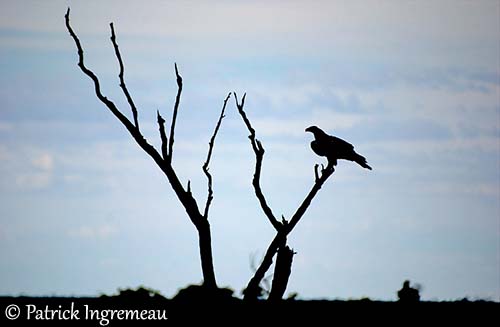
NEW ZEALAND
EXTINCT ENDEMIC BIRD SPECIES
Like other countries and islands, New Zealand lost numerous endemic bird species when humans, Maori first and Europeans later, started to change the original environment. Various causes such as introduced predators (rats, cats, dogs, pigs, stoats, ferrets…), massive deforestation for logging, agriculture and farming, disturbances on the breeding grounds or at colonies, roads, harbours, cities, all the human developments incompatible with the wild animal life led several endemic bird species to extinction.
We can start with the Haast’s Eagle (Harpagornis moorei), a giant prehistoric predator of the New Zealand fauna.
This large, heavy eagle had a wingspan of up to 3 metres, with a weight of 12 kg (male) and 17 kg (female). It was 90 centimetres tall and about 140 centimetres long. Bill, legs and talons were larger and stronger than those of the largest living eagles. These physical features were confirmed by the study of near-complete skeleton. This eagle was the largest predator of the South Island’s terrestrial species.

This picture displays the Wedge-tailed Eagle, an Australian species, which gives some idea of the general appearance (but much smaller) of this large raptor.
Haast’s Eagle’s preferred prey was the Moa of genus Dinornis, a high flightless bird fairly similar to the Emu, but larger and taller. There were nine different species, all wingless. This bird was herbivore and usually found in the New Zealand forests, shrubland and subalpine areas. It was the main prey of the eagle, and until the arrival of the Maori, this raptor was their unique predator. But due to overhunting by Maori, and changes in the habitat, most species of Moas died, and the Haast’s Eagle did not survive the extinction of its main food source.
This story is today easy to tell, but the following bird species were led to extinction by similar threats and causes.
The Auckland Merganser (Mergus australis) was similar in size to the Red-breasted Merganser. This species was first collected in 1840 by Jules Dumont d’Urville during a subantarctic trip. It was not flightless, but reluctant to take-off, preferring the shelter of rocks is threatened. Hunting by humans and predation by introduced mammals led the species to extinction during the period of Maori occupation. It was resident on the South island and Stewart Island. The last sighting was on January, 1902.
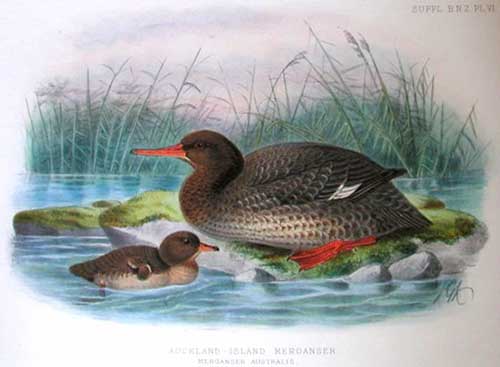
Auckland Merganser
John Gerrard Keulemans
Buller, Walter Lawry
Supplement to Birds of NZ, 1905
The Laughing Owl (Sceloglaux albifacies) or White-faced Owl, was described in 1845, and was abundant but yet declining when the European settlers arrived in New Zealand. The species was completely extinct by 1914.
It was a typical owl with cryptic plumage and white facial disc. Some individual variations were observed with more rufous birds, usually males. With a weight of about 600 grams and a length of 35-40 centimetres, this owl was a medium-sized Strigidae, about twice the size of the Morepork.
The English name of this owl is related to its calls including a variety of whistling, chuckling and mewing notes.
The Laughing Owl was living in rocky, low humid areas and forest in the North Island where its preys (large insects, rodents, birds and lizards) were abundant. The species was common in the South Island in the mid-1800s, but then, it declined rapidly.
Its extinction was caused by persecution, changes in the habitat and predation by cats, and stoats, ferrets and weasels introduced for rabbit control.
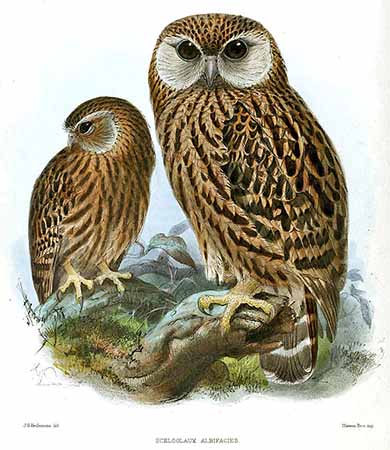
Laughing Owl
John Gerrard Keulemans
Ornithological Miscellany. Volume 1
The New Zealand Quail (Coturnix novaezelandiae) has been extinct since 1875. This bird was described during the first James Cook’s voyage. This small bird of 18-21 centimetres and 200 grams was found in lowland tussock grassland and shrubland, and had terrestrial habits. Its strong legs allowed the bird to run through the thick low vegetation.
This species was common throughout both North and South Islands, in spite being hunted for food by Maori. But it has been extinct following the European settlement. It was predated by rats and dogs, and suffered heavy hunting pressure. But as this bird was primarily herbivore, it is also suggested that burning of the natural grasslands involving habitat and food destruction may have been the main cause of the extinction of this species.
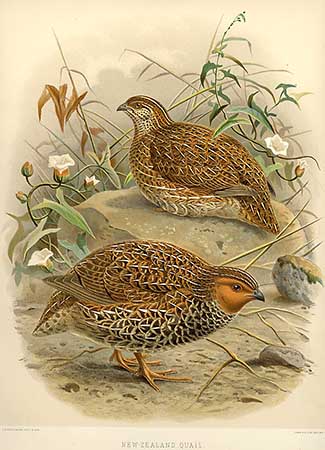
New Zealand Quail
John Gerrard Keulemans
Buller's "A History of the Birds of New Zealand
2nd edition. Published 1888"
The New Zealand Bittern (Ixobrychus novaezelandiae) was last recorded alive in the 1890s. It was described in 1871 as Ardeola Novae Zelandiae, but in 1980, after the discovery of remains in the North Island, this material was identified as New Zealand Bittern. This Ardeidae was a small bittern of 37 centimetres and 250 grams.
From Walter Lawry Buller, author of “A history of the birds of New Zealand” this species was living in the wooded margins of creeks and saline lagoons and its diet included small fish and the roots of reeds. It was always found alone and its feeding behaviour was that of other herons and bitterns, standing motionless in one place during hours or walking slowly in shallow water while searching for preys. .
The extinction of this species is probably due to the early spread of Norway rats and feral cats in New Zealand. Their last period coincides with the stoat invasion on the west Coast. The drainage of the wetlands for farming has come later.
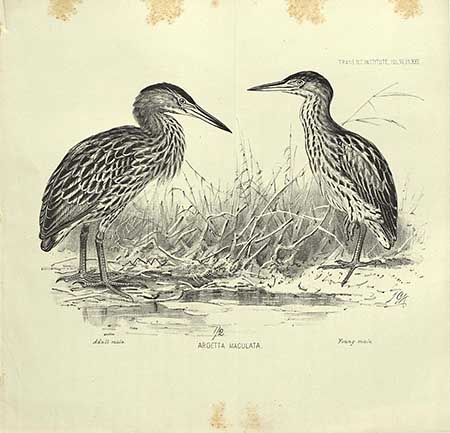
John Gerrard Keulemans (1842-1912) (Illustrator) - Walter Lawry Buller (1838-1906) (Author): Notes on the Little Bittern of New Zealand (Ardetta maculata). In: A History of the Birds of New Zealand
Ardetta maculata (W. L. Buller) is a synonym of Ardeola novaezelandeae (A. C. Purdie) which is identical with the New Zealand Little Bittern (Ixobrychus novaezelandeae)
The Piopio or New Zealand Thrush (Turnagra capensis) is one of two closely related species endemic to New Zealand. Both are now extinct. It was a medium-sized bird of 23-26 centimetres and 130 grams, and an omnivorous species.
This species was called “piopio” (the native thrush) by European settlers, due to its slight resemblance to the introduced smaller Song Thrush (Turdus philomelos). Its melodious song was described as very pleasant and sweet.
This species was abundant throughout the South Island and some islands, but then, it had become scarce, and rapid declines occurred following European settlement after 1870, due to the introduced ship rats, and they disappeared when the stoats reached the West Coast and Fiordland.
However, it was still abundant in podocarp forest and fruiting scrubs from sea-level to the alpine areas of the West Coast in the 1880s, but it was extinct by 1895 in this location.
The North Island Piopio (Turnagra tanagra) is the second member of this genus. This one occurred throughout the North Island. It rapidly declined north to Auckland following European settlement, but the species was still common in the southern North Island by 1860s.
The main cause of the extinction of this species is the predation by ship rats. They were sometimes eaten by settlers, but the complete final extinction was due to the spread of stoats. The last confirmed record was in February 1902 at Ohura. Other sightings until 1970s remained unconfirmed.
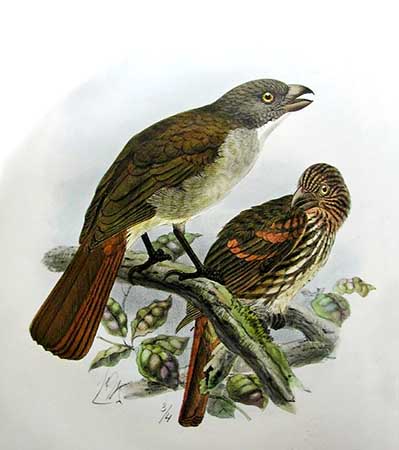
John Gerrard Keulemans
Illustration of the two species.
T. tanagra on the left, T. capensis on the right
Hand coloured lithograph from Buller’s Birds of New Zealand, 1st edition, 1873.
Lithographic plate is by John Gerard Keulemans.
The South Island Kokako and the Huia have been studied on this page:
Family Callaeidae
The Bush Wren and the Stephens Island Wren can be found here:
Family Acanthisittidae
Today, numerous endangered New Zealand species are managed and protected. Conservation actions for pest control and eradication of introduced mammalian predators, captive breeding and translocations to predator-free islands, protection and conservation of habitat and plant species, and restricted access to several sanctuary islands are under way.
Several bird species are recovering slowly and their populations are increasing. However, numerous species have restricted range on islands or small parts of the mainland where the extensive native forest is now reduced.
We have to mention the great job done by the Department of Conservation which manage numerous conservation actions throughout New Zealand and the subantarctic islands.
These birds can be discovered on this page:
New Zealand endemic bird species
Text by Nicole Bouglouan
Photographer:
Patrick Ingremeau
TAMANDUA
Illustrator:
John Gerrard Keulemans (1842-1912)
Sources:
KNOW YOUR NEW ZEALAND BIRDS by Lynnette Moon - New Holland Publishers – ISBN: 1869660897
L’ENCYCLOPEDIE MONDIALE DES OISEAUX - Dr Christopher M. Perrins - BORDAS - ISBN: 2040185607
Wikipedia, the free encyclopaedia
Te Ara – The Encyclopedia of New Zealand
New Zealand birds and birding (Narena Olliver)